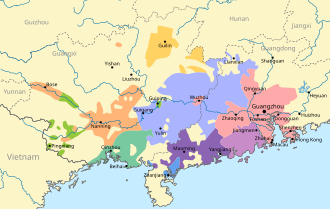Sinitic languages






Sinitic languages, also known as Chinese languages, form a primary branch of the Sino-Tibetan language family. They are spoken predominantly in China, Taiwan, and among the Chinese diaspora worldwide. The most well-known and widely spoken Sinitic language is Mandarin Chinese, which serves as the official language of the People's Republic of China and Taiwan, as well as one of the four official languages of Singapore. Other significant Sinitic languages include Cantonese, Shanghainese, Min, Wu, Xiang, and Hakka.
Classification[edit]
The Sinitic languages are classified into several groups, primarily based on phonetic, lexical, and grammatical differences. These groups are:
- Mandarin: The largest group by number of speakers, including various dialects spoken in northern, southwestern, and northeastern China.
- Wu: Spoken in the eastern coastal province of Zhejiang, the city of Shanghai, and surrounding areas.
- Cantonese (Yue): Predominantly spoken in Guangdong Province, Hong Kong, and Macau.
- Min: Found in the southeastern province of Fujian, Taiwan, and among overseas Chinese communities in Southeast Asia.
- Hakka: Spoken by the Hakka people in several provinces in southeastern China, Taiwan, and by diaspora communities.
- Xiang: Primarily spoken in Hunan Province.
- Gan: Spoken in Jiangxi Province and neighboring areas.
Linguistic Features[edit]
Sinitic languages share several linguistic features, including the use of tones to distinguish meaning, a common set of morphemes, and a tendency towards analytic syntax. However, there is significant variation among the languages in terms of phonology, vocabulary, and grammar.
Tones[edit]
One of the defining characteristics of Sinitic languages is their use of tone to differentiate words. The number of tones varies among the languages, from four in Mandarin to six or more in other languages like Cantonese.
Characters[edit]
Sinitic languages are primarily written using Chinese characters, which are logograms representing words or morphemes. While there is a significant overlap in the characters used across the languages, there are also differences in character usage and meaning.
History[edit]
The history of the Sinitic languages can be traced back to the Old Chinese spoken during the Zhou Dynasty (1046–256 BCE). Over centuries, Old Chinese evolved and diversified into the various Sinitic languages spoken today. The process was influenced by factors such as migration, geographic isolation, and contact with other languages.
Modern Developments[edit]
In the modern era, efforts have been made to standardize and promote the use of Mandarin across China, known as Putonghua in the mainland and Guoyu in Taiwan. This has included the development of a standardized pronunciation, vocabulary, and writing system. Despite these efforts, the other Sinitic languages continue to be spoken and maintain vibrant communities of speakers.
Challenges and Preservation[edit]
The diversity of the Sinitic languages faces challenges from the dominance of Mandarin, leading to concerns about the preservation of the linguistic heritage of China's various ethnic and linguistic groups. Efforts are being made to document and revitalize many of the languages, including through education, media, and cultural initiatives.
Ad. Transform your life with W8MD's Budget GLP-1 injections from $75


W8MD offers a medical weight loss program to lose weight in Philadelphia. Our physician-supervised medical weight loss provides:
- Weight loss injections in NYC (generic and brand names):
- Zepbound / Mounjaro, Wegovy / Ozempic, Saxenda
- Most insurances accepted or discounted self-pay rates. We will obtain insurance prior authorizations if needed.
- Generic GLP1 weight loss injections from $75 for the starting dose.
- Also offer prescription weight loss medications including Phentermine, Qsymia, Diethylpropion, Contrave etc.
NYC weight loss doctor appointmentsNYC weight loss doctor appointments
Start your NYC weight loss journey today at our NYC medical weight loss and Philadelphia medical weight loss clinics.
- Call 718-946-5500 to lose weight in NYC or for medical weight loss in Philadelphia 215-676-2334.
- Tags:NYC medical weight loss, Philadelphia lose weight Zepbound NYC, Budget GLP1 weight loss injections, Wegovy Philadelphia, Wegovy NYC, Philadelphia medical weight loss, Brookly weight loss and Wegovy NYC
|
WikiMD's Wellness Encyclopedia |
| Let Food Be Thy Medicine Medicine Thy Food - Hippocrates |
Medical Disclaimer: WikiMD is not a substitute for professional medical advice. The information on WikiMD is provided as an information resource only, may be incorrect, outdated or misleading, and is not to be used or relied on for any diagnostic or treatment purposes. Please consult your health care provider before making any healthcare decisions or for guidance about a specific medical condition. WikiMD expressly disclaims responsibility, and shall have no liability, for any damages, loss, injury, or liability whatsoever suffered as a result of your reliance on the information contained in this site. By visiting this site you agree to the foregoing terms and conditions, which may from time to time be changed or supplemented by WikiMD. If you do not agree to the foregoing terms and conditions, you should not enter or use this site. See full disclaimer.
Credits:Most images are courtesy of Wikimedia commons, and templates, categories Wikipedia, licensed under CC BY SA or similar.
Translate this page: - East Asian
中文,
日本,
한국어,
South Asian
हिन्दी,
தமிழ்,
తెలుగు,
Urdu,
ಕನ್ನಡ,
Southeast Asian
Indonesian,
Vietnamese,
Thai,
မြန်မာဘာသာ,
বাংলা
European
español,
Deutsch,
français,
Greek,
português do Brasil,
polski,
română,
русский,
Nederlands,
norsk,
svenska,
suomi,
Italian
Middle Eastern & African
عربى,
Turkish,
Persian,
Hebrew,
Afrikaans,
isiZulu,
Kiswahili,
Other
Bulgarian,
Hungarian,
Czech,
Swedish,
മലയാളം,
मराठी,
ਪੰਜਾਬੀ,
ગુજરાતી,
Portuguese,
Ukrainian
